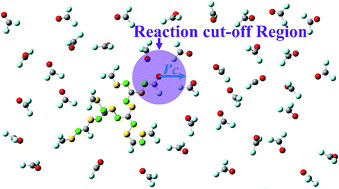A coarse-grained molecular dynamics – reactive Monte Carlo approach to simulate hyperbranched polycondensation†
Abstract
A coarse-grained molecular dynamics (CG-MD) and reactive Monte Carlo (RMC) hybrid method (CG-MD + RMC) has been developed to investigate the hyperbranched polycondensation of 3,5-bis(trimethylsiloxy)benzoyl chloride to poly(3,5-dihydroxybenzoic acid). The CG force field to describe the formation of the hyperbranched macromolecules has been extracted from all-atom molecular dynamics simulations by the mapping technology of iterative Boltzmann inversion. In the mapping process branched poly(3,5-dihydroxybenzoic acid) in an all-atom description has been employed as a target object to derive the CG force field for hyperbranched polymers. In the RMC simulations, the reactivity ratio of the functional groups has been optimized by fitting experimental data with the iterative dichotomy method (Macromolecules, 2003, 36, 97). Using such a simulation framework, detailed information including the molecular weight, the molecular weight distribution and the branching degree of a specific polymerization process has been derived. Radial distribution functions of the atomistic and coarse-grained systems are in excellent agreement. A good agreement between the present simulations and experiment has been demonstrated, too. Especially, the intramolecular cyclization fraction has been reproduced quantitatively. This work illustrates that the present reactive CG-MD + RMC model can be used for quantitative studies of specific hyperbranched polymerizations.


 Please wait while we load your content...
Please wait while we load your content...